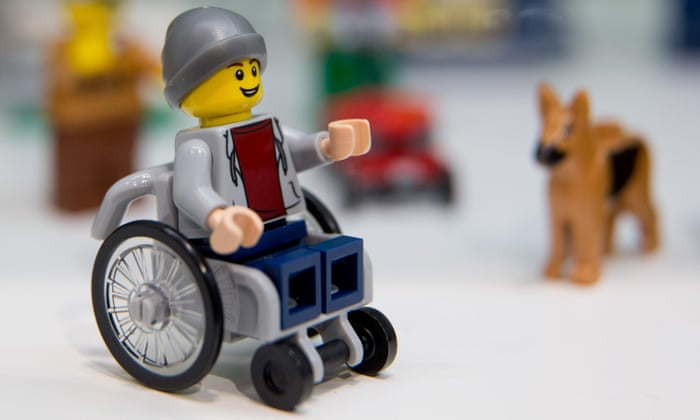
Sometimes the smallest of things have the capacity to make the biggest of impacts. Last week Lego unveiled its first ever wheelchair-using mini-figure at Nuremberg toy fair, an inch-tall plastic boy sporting a beanie and hoodie who forms part of a Fun in the Park going on sale in June this year. For a small guy he’s been making big waves, inspiring global press coverage and online jubilation from Lego fans, parents and disability groups.
“But he’s just a little guy,” I hear you say, “a plastic dude out for a wheel in the park with his dog and a bunch of other mini-figures. What’s the big deal?”
The message behind Lego’s wheelie boy is so much larger than his teeny-tiny stature. His birth in the toy box marks a seismic shift within children’s industries. There are 150 million children with disabilities worldwide, yet until now they have scarcely ever seen themselves positively reflected in the media and toys they consume.
In her recently published book Disability and Popular Culture, Australian academic Katie Ellis writes: “Toys mirror the values of the society that produce them …” If Lego is mirroring, it’s reflecting a better world. Intentionally or not, it has sent out a powerful message of inclusion.
Lego seems to have been unprepared for the excitement its wheelchair-using boy would cause. When he rolled on to the stands of Nuremberg Toy Fair, Lego wasn’t treating him as anything special – he was just nestled among the crowd. The company hadn’t prepared any photos for journalists and, when approached by the Press Association, could only say that he would reach the shops in June. Yet the figure’s very existence was noteworthy, so unusual that he grabbed the headlines during a week of international toy fairs. (Alongside big-bottomed, flat-footed “normal woman” Barbie – but that’s a whole other story.)
The delighted response only highlights the size of the void that Lego’s wheelchair boy comes to fill. This beast is ravenous because we’ve never really fed it before.
The toys, TV, films, games, apps and books that entertain and educate our children barely feature children with any kind of impairment or difference. Their lives are not reflected. They’re invisible. How do you grow a positive self-esteem when the culture around you appears to place no value on your existence? It does not celebrate you. On the rare occasions when you are depicted, it’s frequently as a disability stereotype – in a medical setting (toy hospital set), as an evil baddie (Captain Hook) or associated with charity (BBC’s Children in Need). Your hopes, dreams, imaginations and experiences are ignored. You are culturally marginalised. Washed away by the mainstream. As the academic and bio-ethicist Tom Shakespeare – himself a wheelchair user – said, there’s a danger that disabled children will feel “like permanent outsiders in the world”.
When did you last see disability represented positively in a children’s film, cartoon, or computer game? Have you ever seen a set of emojis that reflect the disabled experience in a celebratory way? Alexandra Strick of Inclusive Minds, a group calling for greater representation of disabled children in publishing, says, “The disturbingly low number of books featuring disabled characters is a perpetual concern. I’m frequently asked for lists of books which feature disabled characters. It’s extremely challenging to find more than a handful.”
Everyone knows there’s something wrong with how we represent disabled people, but it seems no one knows quite how to fix it. We dance delicately around disability, scared to offend or get it wrong, so we don’t do it. This exclusion is causing damage to millions of children, yet the answer is quite simple. Just include it in an incidental, celebratory way. Move on from the baseline negative, which treats disability as somehow lesser, in need of fixing or overcoming, and see it for what it is – benign human variation, part of the spectrum of human life. Let’s hope that one day positive representations of disability are included so seamlessly across children’s industries that they cease to be noteworthy at all.
guardian.co.uk © Guardian News & Media Limited 2010
Published via the Guardian News Feed plugin for WordPress.
Lego’s plastic wheelchair guy is a seismic shift in a toy box











0 comments:
Post a Comment